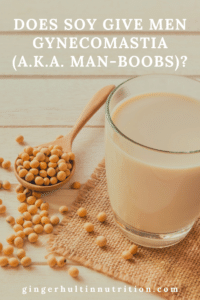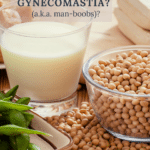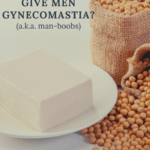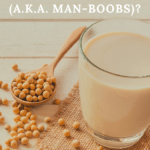Does soy give men Gynecomastia? (aka man-boobs)
April 9, 2015 by Ginger Hultin MS RDN
Soy is a hot nutrition topic so I thought we could do a little myth busting on a common question I get about soy: does soy give men Gynecomastia? (aka man-boobs). Because I’m a plant-based dietitian (though I work with patients on ALL diets), I really wanted to tackle some of these myths that keep circulating. This one is dangerous because it actually prevents men from including a very important food in their diets! I developed a real passion for this topic during my position as Chair a few years back with the Vegetarian Nutrition Dietetic Practice Group. Leading that organization was such a gift and I got to be surrounded by so many experts from around the country.
Soy, along with many other plant-based foods, contains “plant-estrogen,” aka “phytoestrogen.” There’s a popular concern that this compound might imitate human estrogen, potentially stimulating cancer growth… or throwing a wrench into male testosterone levels, leading to the spontaneous development of the dreaded “man-boobs” (not a term I personally choose to use but one I am asked about often). I’m here to sift through the research, providing you with a clear understanding. So, let’s address the burning question: Does soy give men Gynecomastia? (aka man-boobs)?
What do the experts say?
Based on an analysis of current literature, the firm, evidence-based conclusion that the consumption of soy foods does not have an impact on testosterone levels. The consensus is based on a 2021 research analysis of the past two decades, concluding that neither soy nor isoflavone intake affects levels of total testosterone, free testosterone, estradiol, or estrone. Another research analysis demonstrated that soy foods or supplements containing 40-70mg/d of soy isoflavones had no impact on hormones and semen quality. Other studies have found that up to 150mg/day of soy isoflavones have no impact on estrogen levels. To put it in perspective, an entire block of tofu has only 100 grams of isoflavones. Two research studies have found that the consumption of the equivalent of 4 blocks of tofu or 9 cups of soy milk has been shown to have a feminizing effect on men, but that is a TON of tofu and soy milk!
Another controversial study showed a 19% decrease in testosterone in 12 participants after 4 weeks of consuming 56 grams of isolated soy protein daily. For reference, on average most people require between 60-80 grams of protein per day (based on body size). That means that this small group of study participants was eating very large quantities of a processed soy source. My recommendation is not to do this; I would have advised against it even before I read the study.
The consumption of any food can lead to abnormalities; not just soy. It is always recommended to consume whole foods over heavily processed alternatives to avoid the over consumption of a singular nutrient. Overall, there is no concern around eating soy products, even daily. In fact, soy has so many health benefits that it should be classified as a superfood!
Soy as a superfood
The macro and micronutrient composition of soy is truly remarkable. The protein quality of soy is nearly identical to that of meat; it is low in carbohydrates (and therefore suitable for diabetics), and it contains both omega 3 and omega 6 essential fatty acids. Soy has been directly linked to improved cardiovascular health by assisting to lower LDL cholesterol and blood pressure, reducing arterial stiffness, and promoting vasodilation. In addition, the consumption of soy products may reduce rates of cardiovascular events, like heart attacks.
As if heart health is not convincing enough, the consumption of soy has also been demonstrated to be protective against cancer, including prostate cancer. There is some evidence that the isoflavones in soy may inhibit metastasis, the development of secondary malignant growths.
So, is the concern surrounding “man-boobs” a significant enough reason for men to avoid consuming soy and potentially miss out on its numerous health benefits? I would say not. The likelihood of developing “man-boobs” from soy consumption is almost unheard of, whereas cardiovascular disease and prostate cancer stand as prominent causes of mortality in the United States. Embracing a daily intake of soy is not only beneficial but actively encouraged for overall health.
Whole-food soy products such as tofu, soy milk, tempeh, miso, and edamame offer a wealth of health advantages, contributing to heart health and aiding in cancer prevention. It is essential to emphasize the positive impact of these whole-food soy sources. Conversely, caution should be exercised with soy isolates, particularly those containing added sweeteners or preservatives, and their consumption should be kept to a minimum. The overarching message remains clear: the potential concerns related to “man-boobs” should not overshadow the considerable health benefits derived from the consumption of soy.
Does soy give men Gynecomastia? (aka man-boobs)
Please remember that you likely eat plant estrogens every day. Soy may have a higher concentration of them, but a plant fiber called “lignans” found in many plant foods including seeds, whole grains, bran, beans, fruits , and vegetables also contain plant estrogens. According to the Linus Pauling Institute, though most research on phytoestrogen-rich diets has focused on soy isoflavones, lignans are the main source of phytoestrogens in our general diets. If you eat fruits, veggies, beans and whole grains and don’t have man-boobs yet, then you’ll likely be ok eating a little soy.
I have a hard time when someone is telling me they can’t eat soy (which has proven health benefits), but they’re chugging soda, alcohol, or eating sugary desserts. You want to know what will more likely cause man-boobs? Too much chocolate cake and beer.
You can find research to support what you want it to- that is certain. I encourage you to seek advice from individuals who lack a financial stake in the subject they’re discussing. When it comes to questions regarding your health, please find a medical provider, registered dietitian, or researcher who can provide evidence-based insights. Don’t rely solely on advice from friends, nutrition enthusiasts, or Google who tells you to avoid soy because it gives you man-boobs…
Please reach out to me to schedule an appointment to discuss your nutrition needs if you have more questions about using soy foods in your diet.
Soy is a hot nutrition topic but despite controversial claims, soy is a health food that should be a part of your healthy, balanced diet. It is easy and delicious to include soy in your favorite meals, you can use soy milk in your smoothies, add tofu to your stir frys, and enjoy tempeh in your tacos. If you are still concerned about soy, just shy away from processed soy and focus on whole soy products like tofu, tempeh, soy milk, miso, and edamame beans. Soy is a superb complete protein that can help you to reduce your consumption of meat, increase healthy plant-proteins in your diet, and help you to live a happy, healthy life.
What do you think? This can be an emotionally charged and controversial topic – I’d love to hear your feedback and experience!
6 Comments
Leave a Comment

Ginger Hultin,MS, RD, CSO
Thanks for visiting! If you're struggling with a cancer diagnosis, autoimmune condition, gut health problems, or even a medical mystery, nutrition can make a HUGE difference in your day-to-day life. I run a virtual, concierge private practice where I partner with my clients over time to help them improve their health through nutrition. Be sure to visit the blog for easy, plant-based, anti-inflammatory recipes and our "Resources" page for a variety of self-paced programs, books, e-books, and nutrition podcast episodes.







Bcz of this rumor i switched from soy to almond is this switch recommended?
I’m so glad that you asked! Soy milk has a lot more protein so depending on your needs, it could actually be a better fit.
While thoughtful, the article misses a number of key points.
– Essential amino acid profile (EAAP).
– Branch chain amino acid profile (BCAAP; especially important for athletes or those trying to lose weight).
– Calorie-to-density ratio (a small 70g piece of pan-fried calf liver is much easier to consume than 1-2 “bricks” of firm tofu; or a cheeseburger being more convenient to consume than a 2lbs back of chick peas; as contrived/oversimplified examples).
– Bioavailability (Knauss, 2018, for example; gram-for-gram, a cooked whole egg provides roughly 1.5x to over 2.0x the benefit of firm low-moisture tofu, depending on how one interpolates the results).
To the “controversial” Goodin study: the sample size is small, but the methods and nature of the work is legit. There have been no calls for clarification of the results, or formal challenges to quality and/or legitimacy of the results. Further, similar results have been effectively replicated independently (Dillingham, 2005; Hamilton-Reeves, 2007). Calling a study “controversial” without explaining why seems disingenuous.
To my point, let’s just consider an adult needing approximately 0.80g of lean protein per kg of body mass, per day (this is the lower bound; NIH, British Heart Foundation, Mayo Clinic), and is typically reflective of sedentary adults. Moderately athletic individuals may need upwards of 1.1g/kg to 1.5g/kg, or up to 2.0g/kg for athletes and/or very active individuals (Mayo Clinic). Elite athletes will likely exceed this threshold.
Let’s consider the average weight of male athletes by sport:
– Football/soccer: 170lbs (World Cup; self reported).
– Hockey: 245lbs (NHL; self reported).
– Powerlifting: 265lbs (minimum weight to compete in the open division, 120kg+).
Barring the use of PEDs, in general, the numbers above suggest something like so just for daily dietary protein intake (not accounting for macros, vitamins, meal schedules, etc.).
– Football/soccer: 170lbs (77.3kg) body weight X 2.0g/kg protein ==> 154g protein/day
– Hockey: 245lbs (111kg) body weight X 2.0g/kg protein ==> 223g protein/day
– Powerlifting: 265lbs (120kg) body weight X 2.0g/kg protein ==> 241g protein/day
Now, let’s assume one is acquiring the bulk of this protein from a relatively high-bioavailability source (i.e. eggs, red meat, chicken, fish, oily fish like sardines/sprats/mackerel, milk, yoghurt, cottage cheese). Such a diet provides roughly 95% bioavailability, and a very-much complete and broad EAA/BCAA profile. To be fair, we’ll assume some minor contribution/supplementation from incomplete (poor EAA/BCAA profile, low-bioavailability) sources like oats, whole grain pasta, pea-meal protein, beans, legumes, etc. (i.e. no fun to have just meats/proteins; need a nice spaghetti or non-deconstructed-meal on occasion 🙂 ).
Now, let’s repeat this, correcting for EAA/BCAA profiles and bioavailability. We’ll go with soy, since it’s among the few non-animal-based complete proteins. Using my eggs-versus-tofu example, a corrective factor of 0.55x seems appropriate/intellectually-honest.
– Football/soccer: 170lbs (77.3kg) body weight X 2.0g/kg protein ==> 154g protein/day ==> 280g plant-protein/day
– Hockey: 245lbs (111kg) body weight X 2.0g/kg protein ==> 223g protein/day ==> 405g plant-protein/day
– Powerlifting: 265lbs (120kg) body weight X 2.0g/kg protein ==> 241g protein/day ==> 438g plant-protein/day
In all three cases, the individual is well past the danger-zone (i.e. where the testosterone-adverse and cancer-risk concerns are legitimate). Even if we cut the amount in half for sedentary individuals, still in danger zone. Cut it in half again (75% total reduction), for sedentary people with relatively low bodyweights, **still** in the danger zone (i.e. >50g/day).
Even the almond milk comments above: almond milk has a fraction of the protein content of simple 2% or whole milk (i.e. maybe 1-2g tops for almond milk compared to 8g for whole milk, which can go up to 15g/cup if you purchase the nicer ultra-filtered variety). There is an option for soy milk, which can go up to 8g/cup, but, correcting for bioavailability and amino acid profiles, one may need to consume up to triple the amount of liquid to catch up to whole milk. Nearly a quart of fluid versus a cup is a significant difference.
Anyhow, any comparisons like this simply need to take into account bioavailability, calories, EAA/BCAA profiles, and practicality (i.e. cost of multi-source plant-based diets rather than soy-centric, sheer amount of plant-mass one must consume to derive the equivalent nutrient profile, etc. etc.).
Hi there Sherman – thanks so much for such a thoughtful reply! I can tell you’re passionate about protein 🙂 There’s a lot to say about protein sources but ultimately, this post is about the safety of soy – especially for men – and so perhaps I’ll have to tackle the “how much protein do you need’ conversation at another time. My specialty is oncology, not nutrition for athletes, so I hope the information I provided here in the post is relevant for the audience I serve. Thanks for stopping by and you shared some really great resources that I hope readers stop and check out.
Good day Ginger Hultin, CSO;
Thank you for publishing my post. My primary intent is to open a dialogue (when possible/practical) on the topic of BCAA/EAA profiles when comparing dietary options in the context of protein bioavailability, and encouraging more audiences to better understand what “protein quality” means.
I find that in most meta-analyses on soy intake, that the diets of even amateur athletes exceed the “generally recognized as safe” ingestion thresholds. Given the contested/debated potential for health issues should one regularly exceed these thresholds, I feel a need to highlight (academically and/or casually) that it is very easy to cross this threshold, and attention drawn to the issues associated with “excess” soy ingestion.
Have a wonderful year!
Hi there Sherman – yes! So glad to see your passion. You and I are sort of focused on different aspects of soy intake and men’s health, so I just want to acknowledge that for the audience, but that being said, I came across a really interesting new updated meta that I think really highlights the safety of soy in relation to this blog topic – soy and ‘man boobs’ 🙂 Here it is if you want to check it out!
Reed KE, Camargo J, Hamilton-Reeves J, Kurzer M, Messina M. Neither soy nor isoflavone intake affects male reproductive hormones: An expanded and updated meta-analysis of clinical studies. Reproductive Toxicology. 2021 Mar 1;100:60-7.